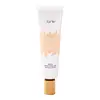What's inside
What's inside
 Key Ingredients
Key Ingredients

 Benefits
Benefits

 Concerns
Concerns

 Ingredients Side-by-side
Ingredients Side-by-side

Water
Skin ConditioningCyclopentasiloxane
EmollientCaprylyl Methicone
Skin ConditioningPhenyl Trimethicone
Skin ConditioningButylene Glycol
HumectantCetyl PEG/PPG-10/1 Dimethicone
EmulsifyingPEG-10 Dimethicone
Skin ConditioningDimethicone
EmollientPolysilicone-11
Disteardimonium Hectorite
StabilisingMica
Cosmetic ColorantTriethoxycaprylylsilane
Phenoxyethanol
PreservativePolymethylsilsesquioxane
Propylene Carbonate
SolventEthylhexyl Methoxycinnamate
UV AbsorberSodium Chloride
MaskingButyl Methoxydibenzoylmethane
UV AbsorberSilica
AbrasiveDimethicone/Vinyl Dimethicone Crosspolymer
Skin ConditioningGlycerin
HumectantJania Rubens Extract
Skin ConditioningBenzophenone-3
UV AbsorberEthylhexylglycerin
Skin ConditioningPhospholipids
Skin ConditioningParfum
MaskingLauroyl Lysine
Skin ConditioningLaureth-12
EmulsifyingPhenethyl Alcohol
MaskingSodium Carrageenan
Emulsion StabilisingCI 77891
Cosmetic ColorantCI 77491
Cosmetic ColorantCI 77492
Cosmetic ColorantCI 77499
Cosmetic ColorantWater, Cyclopentasiloxane, Caprylyl Methicone, Phenyl Trimethicone, Butylene Glycol, Cetyl PEG/PPG-10/1 Dimethicone, PEG-10 Dimethicone, Dimethicone, Polysilicone-11, Disteardimonium Hectorite, Mica, Triethoxycaprylylsilane, Phenoxyethanol, Polymethylsilsesquioxane, Propylene Carbonate, Ethylhexyl Methoxycinnamate, Sodium Chloride, Butyl Methoxydibenzoylmethane, Silica, Dimethicone/Vinyl Dimethicone Crosspolymer, Glycerin, Jania Rubens Extract, Benzophenone-3, Ethylhexylglycerin, Phospholipids, Parfum, Lauroyl Lysine, Laureth-12, Phenethyl Alcohol, Sodium Carrageenan, CI 77891, CI 77491, CI 77492, CI 77499
Cyclopentasiloxane
EmollientIsododecane
EmollientMica
Cosmetic ColorantPolysilicone-11
Polymethylsilsesquioxane
Zinc Oxide
Cosmetic ColorantHexyl Laurate
EmollientPolyglyceryl-4 Isostearate
EmulsifyingCetyl PEG/PPG-10/1 Dimethicone
EmulsifyingAlumina
AbrasiveDiamond Powder
AbrasiveDipalmitoyl Hydroxyproline
Skin ConditioningPEG-10 Dimethicone
Skin ConditioningStearic Acid
CleansingTriethoxycaprylylsilane
CI 77891
Cosmetic ColorantIron Oxides
Cyclopentasiloxane, Isododecane, Mica, Polysilicone-11, Polymethylsilsesquioxane, Zinc Oxide, Hexyl Laurate, Polyglyceryl-4 Isostearate, Cetyl PEG/PPG-10/1 Dimethicone, Alumina, Diamond Powder, Dipalmitoyl Hydroxyproline, PEG-10 Dimethicone, Stearic Acid, Triethoxycaprylylsilane, CI 77891, Iron Oxides
Ingredients Explained
These ingredients are found in both products.
Ingredients higher up in an ingredient list are typically present in a larger amount.
This ingredient is a high molecular weight silicone. It has emulsifying and skin conditioning properties.
Ci 77891 is a white pigment from Titanium dioxide. It is naturally found in minerals such as rutile and ilmenite.
It's main function is to add a white color to cosmetics. It can also be mixed with other colors to create different shades.
Ci 77891 is commonly found in sunscreens due to its ability to block UV rays.
Learn more about CI 77891Cyclopentasiloxane, or D5, is a silicone used to improve texture of products and trap moisture.
D5 is considered lightweight and volatile. Volatile means it evaporates quickly after application. Once evaporated, D5 leaves a thin barrier that helps keep skin hydrated.
It is also an emollient. Emollients help soften the skin and prevent water loss. Silicones create a silky texture in products. D5 helps other ingredients become more spreadable.
Studies show D5 is safe to use in skincare products. We recommend speaking with a skincare professional if you have concerns.
Learn more about CyclopentasiloxaneMica is a naturally occurring mineral used to add shimmer and color in cosmetics. It can also help improve the texture of a product or give it an opaque, white/silver color.
Serecite is the name for very fine but ragged grains of mica.
This ingredient is often coated with metal oxides like titanium dioxide. Trace amounts of heavy metals may be found in mica, but these metals are not harmful in our personal products.
Mica has been used since prehistoric times throughout the world. Ancient Egyptian, Indian, Greek, Roman, Aztec, and Chinese civilizations have used mica.
Learn more about MicaPeg-10 Dimethicone is silicone with conditioner and emulsifier properties. It mostly acts as an emollient in skincare and and humectant in haircare.
According to the manufacturer, acidic formulations decrease the stability of this ingredient. It works best in neutral or near neutral formulations.
Polymethylsilsesquioxane is a silicone used as a film forming agent.
When applied to the skin, this ingredient creates an invisible film on the surface. This film still allows oxygen to pass through, but prevents moisture from escaping. This can help condition and hydrate the skin. It also leaves a silky feel when applied.
Polymethylsilsesquioxane has not been shown to clog pores. It has been deemed safe to use up to 55%, but most cosmetics use much less.
If you have concerns about using this ingredient, we recommend speaking with a professional.
Learn more about PolymethylsilsesquioxanePolysilicone-11 is a film-forming silicone that creates a non-tacky and matte finish on the skin. It's commonly used to improve texture, absorb excess oil, and help active ingredients spread evenly.
Due to its "rubber-like" structure, it stays on the skin's surface instead of being absorbed. On the skin, it creates a flexible layer that enhances wearability and stability.
Triethoxycaprylylsilane is a silicone used to bind and stabilize ingredients.
As an emulsifier, it helps prevent ingredients from separating. This can help elongate the shelf life of products.
Triethoxycaprylylsilane is often used to coat mineral sunscreens ingredients to help give a better feel. It also helps reduce oxidative stress in sunscreens.
Learn more about Triethoxycaprylylsilane